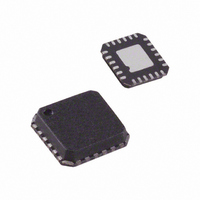AD8340ACPZ-WP Analog Devices Inc, AD8340ACPZ-WP Datasheet - Page 10

AD8340ACPZ-WP
Manufacturer Part Number
AD8340ACPZ-WP
Description
IC MOD VECT 700-1000MHZ 24-LFCSP
Manufacturer
Analog Devices Inc
Datasheet
1.AD8340ACPZ-REEL7.pdf
(20 pages)
Specifications of AD8340ACPZ-WP
Function
Vector, Modulator
Lo Frequency
700MHz ~ 1GHz
Rf Frequency
700MHz ~ 1GHz
P1db
11dBm
Noise Floor
-149dBm/Hz
Current - Supply
150mA
Voltage - Supply
4.75 V ~ 5.25 V
Test Frequency
880MHz
Package / Case
24-VFQFN, CSP Exposed Pad
Lead Free Status / RoHS Status
Lead free / RoHS Compliant
AD8340
THEORY OF OPERATION
The AD8340 is a linear RF vector modulator with Cartesian
baseband controls. In the simplified block diagram shown in
Figure 26, the RF signal propagates from the left to the right
while baseband controls are placed above and below. The RF
input is first split into in-phase (I) and quadrature (Q) compo-
nents. The variable attenuators independently scale the I and Q
components of the RF input. The attenuator outputs are then
summed and buffered to the output.
By controlling the relative amounts of I and Q components that
are summed, the AD8340 allows continuous magnitude and
phase control of the gain. Consider the vector gain representa-
tion of the AD8340 expressed in polar form in Figure 27. The
attenuation factors for the I and Q signal components are
represented on the x- and y-axis, respectively, by the baseband
inputs, V
vector gain, which can also be expressed as a magnitude and
phase. By applying different combinations of baseband inputs,
any vector gain within the unit circle can be programmed.
A change in sign of V
in sign of the gain or as a 180° phase change. The outermost
circle represents the maximum gain magnitude of unity. The
circle origin implies, in theory, a gain of 0. In practice, circuit
mismatches and unavoidable signal feedthrough limit the
minimum gain to approximately −40 dB. The phase angle
between the resultant gain vector and the positive x-axis is
defined as the phase shift. Note that there is a nominal,
systematic insertion phase through the AD8340 to which
the phase shift is added. In the following discussions, the
systematic insertion phase is normalized to 0°.
The correspondence between the desired gain and phase
setpoints, Gain
and V
where:
V
V
respectively.
Note that when evaluating the arctangent function, the proper
phase quadrant must be selected. For example, if the principal
value of the arctangent (known as the arctangent(x)) is used,
Quadrant 2 and Quadrant 3 would be interpreted mistakenly
as Quadrant 4 and Quadrant 1, respectively. In general, both
V
the phase.
O
BBI
BBI
is the baseband scaling constant (500 mV).
and V
and V
Gain
Phase
BBQ
, is given by simple trigonometric identities.
BBI
SP
BBQ
BBQ
SP
and V
=
=
are the differential I and Q baseband voltages,
are needed in concert to modulate the gain and
SP
arctan
(
V
and Phase
BBQ
BBI
. The resultant vector sum represents the
BBI
/
(
V
V
BBQ
or V
O
)
SP
/
2
V
BBQ
, and the Cartesian inputs, V
+
BBI
(
V
can be viewed as a change
)
BBQ
/
V
O
)
2
BBI
Rev. B | Page 10 of 20
Pure amplitude modulation is represented by radial movement
of the gain vector tip at a fixed angle, while pure phase modula-
tion is represented by rotation of the tip around the circle at a
fixed radius. Unlike traditional I-Q modulators, the AD8340 is
designed to have a linear RF signal path from input to output.
Traditional I-Q modulators provide a limited LO carrier path
through which any amplitude information is removed.
SINGLE-ENDED OR
RF QUADRATURE GENERATOR
The RF input is directly coupled differentially or single-endedly
to the quadrature generator, which consists of a multistage RC
polyphase network tuned over the operating frequency range of
700 MHz to 1000 MHz. The recycling nature of the polyphase
network generates two replicas of the input signal, which are
in precise quadrature, that is, 90°, to each other. Because the
passive network is perfectly linear, the amplitude and phase
information contained in the RF input is transmitted faithfully
to both channels. The quadrature outputs are then separately
buffered to drive the respective attenuators. The characteristic
impedance of the polyphase network is used to set the input
impedance to the AD8340.
DIFFERENTIAL
50Ω INPUT Z
MIN GAIN < –30dB
Figure 26. Simplified Architecture of the AD8340
Q CHANNEL INPUT
MAX GAIN = 0dB
I CHANNEL INPUT
–0.5
Figure 27. Vector Gain Representation
0°/90°
V-I
V-I
ATTENUATOR
ATTENUATOR
LINEAR
LINEAR
V
V
BBQ
BBI
V
q
+0.5
–0.5
|A|
θ
A
DISABLE
OUTPUT
I-V
+0.5
SINGLE-ENDED OR
DIFFERENTIAL
50Ω OUTPUT
V
i













